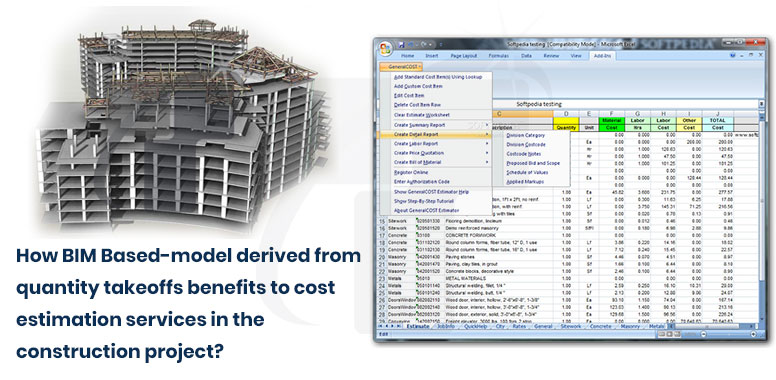How BIM Based-model derived from quantity takeoffs benefits to cost estimation services in the construction project?

Overview
BIM has transformed the construction industry and the way it used to deal with complex projects. It started with creating 3D virtual model shifting its focus to BIM 4D Modeling Services and 5D BIM Services cost planning for construction firms.
Quantity takeoffs are an essential aspect of the Construction Estimating Services in the construction project. It can be used in small, medium, and large projects to determine cost estimation by all the construction trades. It depicts the list of material to be used in a project. The estimator defines the amount of material required and its associated costs.
To get the cost estimates of material, the estimator needs to get accurate and proper drawings, models, or blueprint. The information processed by the quantity takeoffs has collaborated with the estimation of labor costs, overhead costs, etc.
Quantity takeoffs must be accurate and up-to-date as it represents a sizeable portion of material costs. It is performed before the bidding process, and any adjustment made by the estimator can be made in the quantity takeoffs.
Types of Quantity Takeoffs
Quantity takeoffs are prepared by many people involved in, and it needs to be unique. Every individual that define quantity takeoffs may have different methods and can format the final quantity of cost analysis.
Manual Quantity Takeoffs
Manual quantity takeoff is determined without any assistance of digital takeoff software. It is entirely prepared by hands, and the estimator would work on physical drawings to create a list of materials. Even today the information is stored by hand in quantity takeoffs being accessed in digital software. Calculation by hand would be more complexed than doing on software.
Digital Quantity Takeoffs
Digital Quantity Takeoffs are prepared on BIM software like Revit that contains digital capability. For easy calculation of material procurement in quantity takeoffs, running it in construction estimating software can be used. Drawings are uploaded or scanned into the program which analyzes the drawings and generates a list of material required in it.
Adjustment and wastage analysis of material and to order materials can be easily done in the digital software, which reduces errors associated with quantity takeoffs. It needs much less time to get produced than manual quantity takeoffs.
5D BIM Modeling Services and Cost-estimation
5D BIM Services connects a 3D object, its part and entire assembly model to the third party cost estimating software and reflects cost changes whenever any change is made to design or materials. All the construction professionals such as general contractors, surveyors, etc. can evaluate the design changes and stay on budgets.
It can help to make the bidding accurate, reduces approximation needs, and iterations. It prevents better decision making and enhances predictability in building construction, planning of logistics, and scheduling is attained.
Budgets Control
Subcontractors need documentation for coordinating tasks with an internal and external team or organization when prefabrication projects are to be done. But with 5D BIM Modeling implementation, it can make estimates, bids, material takeoffs, etc. accurate.
Subcontractors use Revit to eliminate the need to develop an understanding of drawings and calculate QTQs by manual methods, which reflects accuracy in the outcome.
Cost Estimation and interoperability for a general contractor
Most beneficial from BIM-based cost estimation and QTQs is General Contractors who manage expensive items like facades, MEP Equipment, etc. With 3D Modeling and then adding to 4D and 5D elements to cost-estimation, the process is carried out in a common data environment.
Design data is shared through exchange formats like COBie to share from all the disciplinarians without losing design data. Due to interoperability, decision-making for general contractors has helped in resource management.
Benefits of 5D BIM Modeling
5D BIM Modeling has brought many benefits to the construction industry, such as an increase in efficiency of estimation, saves time when done with the BIM process. Estimation with BIM is much faster than the manual methods and completes the project in half a time.
Design stages and construction planning is added value to the estimation services that makes the calculation much easier and accurate.
Conclusion
Quantity takeoff, when done with BIM software like Revit, calculates material procurement much faster, easier, and saves times. Digital quantity takeoff makes the model calculation of cost estimating services accurate and precise that helps the General Contractors, Subcontractors, and other construction traders to make a decision accordingly.

